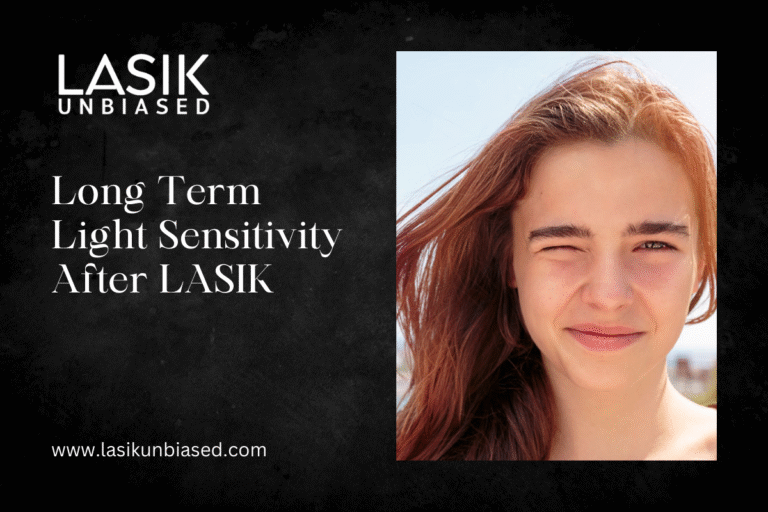Light sensitivity after LASIK is a possible side effect, typically short-term, though a small percentage of patients may experience it for several months or longer.
Understanding why it occurs, how to manage it, and what precautions to take can help those affected lead a more comfortable post-LASIK life.
Laser-Assisted in Situ Keratomileusis (LASIK) is a widely performed refractive surgical procedure designed to reshape the cornea, thereby addressing vision issues such as myopia, hyperopia, and astigmatism. While most patients enjoy remarkable visual clarity post-procedure, some experience lingering side effects. Among these side effects, light sensitivity, or photophobia, typically resolves within weeks, but in rare cases, it can persist longer and may indicate other underlying conditions. Understanding what causes it and how to handle it is crucial to ensure a smooth recovery and maintain quality of life.
Why Does Light Sensitivity Occur After LASIK?
Post-Surgical Healing Process
Light sensitivity frequently arises due to the healing of the corneal nerves, which are temporarily disrupted during LASIK. When the cornea is reshaped with a laser, the nerves responsible for regulating tear production and relaying light perception to the brain are affected. During the recovery phase, heightened sensitivity may be the body’s response to this nerve regeneration. For some, this process may take longer, extending light sensitivity into the long term.
Changes in Tear Production
Another contributing factor is alterations in tear production. A reduction in tear volume post-surgery can exacerbate dry eyes, making them more prone to light sensitivity. Normal tear distribution helps scatter light evenly across the cornea, but in its absence, the eyes may become irritated and overly sensitive to brightness, particularly in environments with glare.
Corneal Structural Adjustments
The reshaping of the cornea itself can also lead to increased light reflection and refraction. This structural change may affect how light enters the eye post-surgery, sometimes contributing to prolonged sensitivity.
Signs and Symptoms to Watch For
Difficulty in Bright Environments
Those experiencing long-term light sensitivity may struggle in sunny or brightly lit indoor spaces. Sunlight, fluorescent lights, and even car headlights at night can become overwhelmingly intense.
Persistent Glare or Halos
Some individuals report seeing halos or glare around bright objects, particularly at night. These visual disruptions can make driving in low-light conditions more challenging.
Eye Strain and Discomfort
Extended exposure to light may result in discomfort, eye strain, or headaches. These symptoms can negatively affect daily activities like reading or working on a computer.
Factors That Increase Susceptibility
Pre-Surgery Dry Eye
Patients who experienced dry eye syndrome before LASIK are at a higher risk of developing sensitivity to light post-surgery. Pre-existing tear film issues can exacerbate discomfort during the healing phase.
Underlying Eye Conditions
Certain eye conditions, such as corneal dystrophies or thin corneal profiles, may increase the likelihood of extended light sensitivity.
Age and Lifestyle
Older age and prolonged exposure to screens or outdoor sunlight can heighten the risk of experiencing such issues. Individuals with high screen usage may find digital glare more noticeable post-surgery.
Managing Long-Term Light Sensitivity After LASIK
Wear Protective Sunglasses
Invest in premium sunglasses equipped with UV protection to safeguard your eyes from harmful ultraviolet rays. Polarised lenses are particularly effective at reducing glare, making them indispensable for outdoor activities.
Use Prescribed Lubricating Drops
Artificial tears recommended by your ophthalmologist can address dry eye symptoms and ease sensitivity. Regular application can help maintain a smooth and moist ocular surface.
Limit Exposure to Intense Light
Adjusting your environment to minimise harsh lighting can be beneficial. Use curtains to control indoor brightness and opt for diffused lighting solutions to create a more comfortable setting.
Supplement with Omega-3 Fatty Acids
Studies indicate that omega-3 fatty acids can improve tear production and reduce dryness, which may indirectly alleviate sensitivity over time. Incorporate oily fish, flaxseeds, or supplements into your diet.
Explore Neuroadaptation
Some experts suggest that gradual exposure to increasing light levels—known as neuroadaptation—can help retrain the brain’s response to light stimuli, particularly in mild cases of photophobia. Consult with your ophthalmologist to determine if this might be a viable option for you.
Lifestyle Adjustments for Greater Comfort
Maintain a Regular Care Routine
Ensure that you follow all post-surgical care guidelines provided by your healthcare provider. This includes regular cleaning of the eyelids and adhering to follow-up appointments.
Blue Light Blocking
For those experiencing digital eye strain, blue light-blocking glasses or screen filters can minimise discomfort during prolonged screen use. These tools reduce glare and ease the toll of artificial light on sensitive eyes.
Avoid Excessive Screen Time
Limit device use or take frequent breaks using the 20-20-20 rule (look away from your screen every 20 minutes and focus on something 20 feet away for 20 seconds). This reduces strain and helps manage sensitivity.
When to Seek Professional Guidance?
Prolonged Symptoms
If light sensitivity persists beyond a few months or worsens, it’s crucial to consult an ophthalmologist, as it may be related to conditions such as dry eye or ocular neuropathic pain. They may recommend additional treatments or explore whether other conditions may be contributing to discomfort.
Signs of Infection
Redness, pain, or discharge may indicate an underlying infection requiring immediate attention. These symptoms should not be ignored under any circumstances, as they could exacerbate light sensitivity.
Refitting Contact Lenses for Residual Symptoms
For patients with persistent halos, glare, or photophobia, speciality contact lenses such as scleral lenses may provide relief by improving corneal surface uniformity and reducing light scatter.
Advances in Managing Post-LASIK Light Sensitivity
Customised LASIK Techniques
Recent advancements in LASIK technology, such as wavefront-guided procedures, focus on reducing the risks of glare and halos. These methods specifically address how light enters the eye, leading to fewer side effects.
Advanced Tear Therapies
Emerging treatments like intense pulsed light (IPL) therapy for chronic dry eye show promise in combating post-LASIK sensitivity. These therapies improve tear gland functionality, providing more comfort.
Corneal Neurostimulation Devices
Cutting-edge devices are being developed to stimulate corneal nerves, promoting faster healing. They aim to address both dry eye symptoms and sensitivity issues post-LASIK.
Final Thoughts on LASIK Light Sensitivity
While light sensitivity after LASIK can be an inconvenient side effect, only a small percentage of patients experience long-term challenges. By understanding the causes and management strategies, you can make informed decisions to live more comfortably.
If you are scheduled for LASIK or are experiencing prolonged sensitivity, consult your ophthalmologist to explore tailored solutions. Modern interventions, patient diligence, and proactive care are key to minimising discomfort and maximising the surgery’s benefits.


